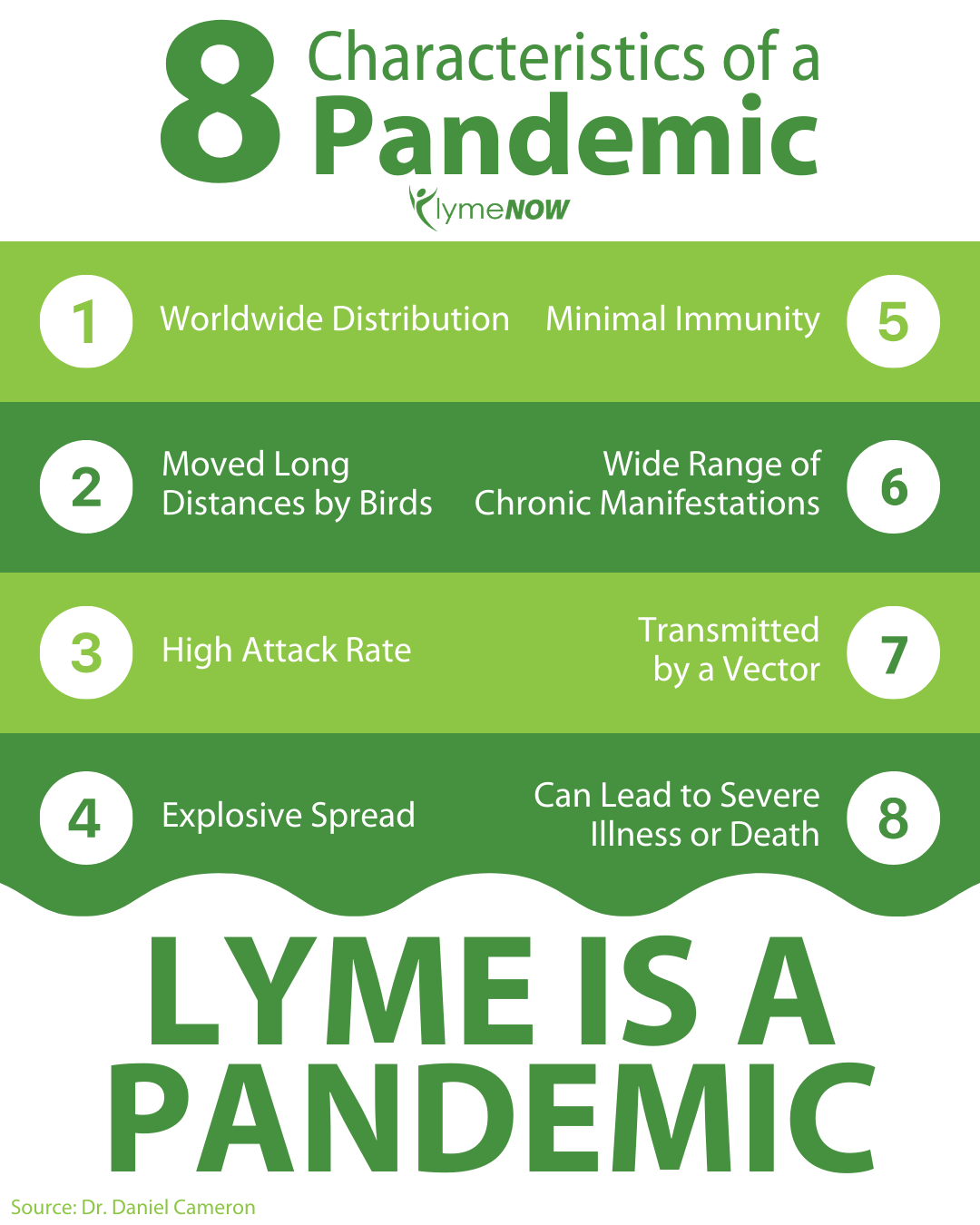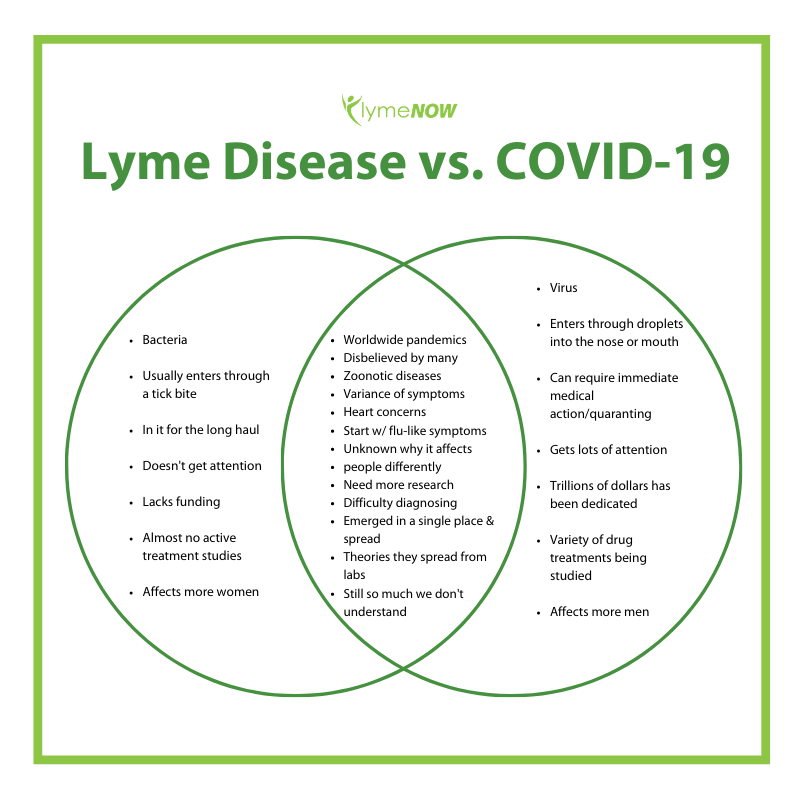The Other Pandemic: Lyme Disease
Do you realize that we are living in not one, but TWO worldwide pandemics right now? The obvious one being COVID-19. The forgotten pandemic that continues to be overshadowed by COVID-19? That’s Lyme disease.
The funny (not really, funny) thing is that both Lyme disease and COVID-19 have a ton in common. And in an age where COVID-19 has demanded precedence, we decided to reflect on this past year and the dramatic impact it has had on Lyme: how it has affected those with Lyme and what it means going forward.
Why is Lyme considered a pandemic?
According to the WHO, a pandemic is defined as “an epidemic occurring worldwide, or over a very wide area, crossing international boundaries and usually affecting a large number of people”. The classical definition includes nothing about population immunity, virology or disease severity.

The Journal of Infectious Disease states these 8 key features of a pandemic:
- Wide geographic extension. Lyme disease has spread worldwide and is found on every continent except Antarctica.
- Disease movement. Birds that carry infected ticks have spread via transmission that can be traced from place to place.
- High attack rates and explosiveness. While there is some disagreement regarding this one, Lyme attack rates and symptomatic cases are high.
- Minimal population immunity. Lyme can affect all persons no matter age or gender, making no one fully protected or immune from infection.
- Novelty. Lyme disease is a fairly new disease and is unusual in how the bacteria continues to stay active in the body (repeatedly reemerging diseases.)
- Infectiousness. Lyme is transmissible and not caused by a non-infectious condition, such as obesity.
- Contagiousness. While Lyme is not contagious via person to person (except in utero cases), it is transmitted through multiple mechanisms.
- Severity. Pandemics can refer to severe and fatal diseases, as well as ones of low or moderate severity.
(Source: Morens and Colleagues, Dr. Daniel Cameron)
Why is Lyme not always considered a pandemic then?
Even though Lyme meets all of these qualifications, there are a few reasons why Lyme might not be universally accepted as a pandemic.
First, a pandemic does not fully take into account the severity of an illness. (Both COVID-19 and Lyme have cases of both mild to life-threatening.)
Next, seasonal epidemics do not count. People often believe Lyme is seasonal during summer months and recurring each summer. However, Lyme can be transmitted during all seasons of the year.
According to an article by Dr. Kelly in the WHO, “a true influenza pandemic occurs when almost simultaneous transmission takes place worldwide.” Even though people are being infected with Lyme at the same time all over the world, it can be hard to recognize that it is happening all at once. So many people don’t even realize that what they have is Lyme disease.
Being referred to as a pandemic alerts the public that their safety is at risk. Getting this recognition alone could help save millions of people from Lyme disease through awareness alone.
What do Lyme and COVID-19 have in common?
Similarities between Lyme disease and COVID-19:
- Worldwide pandemics
- Disbelieved by many
- Zoonotic diseases
- Refers to infectious diseases transmitted between species from animals to humans
- Variance of symptoms
- Some people don’t experience as adverse of effects/ asymptomatic/chronic issues
- Heart concerns
- COVID-19 attacks the lung tissue, but that often means the heart has to work harder to pump oxygenated blood through the body. Lyme bacteria can enter the heart and cause heart block and Lyme carditis
- Start w/ flu-like symptoms
- Prolonged debilitating symptoms
- Many continue to suffer after treatment for both COVID-19 and Lyme. Chronic lung issues persist after COVID-19 and chronic immune issues persist after chronic Lyme.
- Unknown why it affects people differently
- COVID-19 symptoms are usually less severe in younger people, but there have been cases contrary to this. Lyme disease can be successfully treated with antibiotics for some people and unsuccessfully for others.
- Need more research
- There is still so much we don’t know about the lasting effects of COVID-19 and Lyme.
- Difficulty diagnosing
- Testing is limited and not always accurate. According to Forbes, “COVID-19 antigen tests have been unreliable with false negatives in up to 30% of tests. With Lyme, despite years of study, diagnostic tests are likely only ~50% accurate in diagnosing the disease.”
- Emerged from a single place & then spread
- Government involvement surrounding it
- Both diseases get government funding and policies that dictate the future of these diseases regarding statistics, published journals, vaccines, drugs, treatments, insurance coverage, etc.
- Theories they spread from labs
- The theory that the coronavirus was lab-created in Wuhan, China rings similar to the theory that Lyme disease was created in a U.S. bioware lab in Plum Island.
- Still so much we do not understand

Differences between Lyme disease and COVID-19:
- Bacteria versus virus
- Lyme is caused by the spirochete Borrelia burgdorferi. COVID-19 is caused by a virus strain SARS-CoV-2.
- How it enters your body
- Lyme enters into the bloodstream usually through a bite, while COVID-19 enters through droplets into the nose or mouth and then makes its way to the bloodstream.
- The immediacy of COVID-19
- Lyme sufferers tend to be in it for the long haul, while COVID-19 symptoms involve lung issues that often require more immediate attention and quarantining.
- Attention COVID-19 gets
- COVID-19 gets WAY more attention than Lyme disease. Every news story in the past year has overshadowed Lyme news.
- COVID-19 funding much higher
- Trillions of dollars has been dedicated to COVID-19. Lyme disease funding is bunched in with all vector-borne and tick diseases and is in the millions.
- Almost no active treatment studies for Lyme
- Rightfully so, a variety of drug treatments are being studied for COVID-19, but the accepted Lyme disease treatment continues to be doxycycline even after 40+ years of knowing it isn’t always effective.
- COVID-19 affects more men and Lyme more women
- Note: This may be just one reason that COVID-19 gets more attention due to the popular opinion that men are believed more than women in the medical community.
Don’t get us wrong, we understand there are clear distinctions between COVID-19 and Lyme disease, and we don’t believe that the world needs to shut down and enter a state of panic due to Lyme. There has to be somewhere in between, though, right?
If Lyme is so serious, why don’t people seem to care?
Unfortunately, people often have a hard time believing in or caring about things that they have not personally experienced. Until people experienced a city on lockdown or a family member in the ICU, COVID-19 wasn’t always taken seriously. Despite that, many people still do not take COVID-19 seriously, regardless of health recommendations. It’s the nature of society to question disease!
Here are a few reasons people might not seem to care about Lyme in comparison to COVID-19:
- COVID-19 symptoms usually appear all at once, but Lyme symptoms can take a long time to manifest themselves.
- We are not seeing its contagion or spreading in the same manner.
- People with COVID-19 are infecting other people.
Lyme Disease in the Era of COVID-19
Those with diminished immunity from Lyme are more susceptible to COVID-19. Lyme patients’ compromised immune systems resulted in a portion of society being more vulnerable than ever before.
Aside from the mental and physical challenges COVID-19 presents, there is also the question of whether or not people with Lyme were able to receive a Lyme diagnosis in this era. This study proposes that “the co-occurrence of COVID-19 and Lyme disease during the spring of 2020 resulted in a delayed diagnosis of Lyme disease due to COVID-19 pandemic-related changes in healthcare workflow and diagnostic reasoning.”
A delayed Lyme diagnosis can mean the difference between fully healing and living with chronic debilitating Lyme symptoms.
Telemedicine and Lyme Disease
 Potentially, this delay in Lyme diagnosis will set back Lyme disease and its treatment and recovery even further than it already was. However, with the adoption of telemedicine as a normal practice, we also wonder if this could be a helpful tool in diagnosing Lyme disease. On one hand, it makes the physical exam more challenging, which is crucial to an accurate diagnosis. And yet, telemedicine can make seeing a physician far more accessible (many Lyme literate doctors are hundreds of miles away making it inconvenient and costly to travel to your doctor), which could lead to earlier diagnosis and treatment.
Potentially, this delay in Lyme diagnosis will set back Lyme disease and its treatment and recovery even further than it already was. However, with the adoption of telemedicine as a normal practice, we also wonder if this could be a helpful tool in diagnosing Lyme disease. On one hand, it makes the physical exam more challenging, which is crucial to an accurate diagnosis. And yet, telemedicine can make seeing a physician far more accessible (many Lyme literate doctors are hundreds of miles away making it inconvenient and costly to travel to your doctor), which could lead to earlier diagnosis and treatment.
We are curious how this conversation will play itself out as we advocate for better health coverage regarding Lyme disease.
The Lyme Community’s Plea for Help
To anyone reading this, we beg you to take Lyme disease seriously and help us spread awareness of its severity.
This past year has shown people the devastating effects of isolation, both mentally and physically—something Lyme patients have been dealing with for years.
Imagine the progress Lyme could make if given the same attention as COVID-19! We aren’t the first to report that, and hopefully, there will be articles written years from now about how COVID-19 paved the way for the successful treatment, vaccination, and prevention of Lyme disease.
We have now seen what is possible! Vaccines! Clinical trials! Public health campaigns! They did it QUICKLY and they found the money to do so.
Government funding, political involvement, and acknowledgement from insurance companies are just a few of the things the Lyme community NEEDS if it stands a fighting chance. We have certainly seen misinformation regarding COVID-19, but a resounding message of it all is that it is accepted as real! There are opportunities for people to protect themselves from disease that are not available to those with Lyme. That would be a dream for the Lyme community!
We’re living in two worldwide pandemics with COVID-19 and Lyme disease, and there is so much that each community can learn from one another. As the world begins to normalize from the effects of COVID-19, we hope people will realize the severity of Lyme disease and be empathetic to how vital it is to band together during times of pandemic crisis and create much needed positive change in the healthcare industry.
Click here to learn more about Lyme disease.
Follow LymeNow on Instagram.

